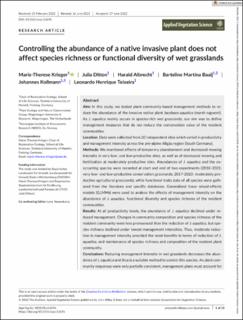| dc.contributor.author | Krieger, Marie-Therese | |
| dc.contributor.author | Ditton, Julia | |
| dc.contributor.author | Albrecht, Harald | |
| dc.contributor.author | Baaij, Barteline Martina | |
| dc.contributor.author | Kollmann, Johannes | |
| dc.contributor.author | Teixeira, Leonardo Henrique | |
| dc.date.accessioned | 2022-11-04T18:52:36Z | |
| dc.date.available | 2022-11-04T18:52:36Z | |
| dc.date.created | 2022-10-26T09:52:57Z | |
| dc.date.issued | 2022-07-17 | |
| dc.identifier.citation | Applied Vegetation Science. 2022, 25 (3), 1-13. | en_US |
| dc.identifier.issn | 1402-2001 | |
| dc.identifier.uri | https://hdl.handle.net/11250/3030260 | |
| dc.description.abstract | Aim: In this study, we tested plant community-based management methods to reduce the abundance of the invasive native plant Jacobaea aquatica (marsh ragwort). As J. aquatica mainly occurs in species-rich wet grasslands, our aim was to define management measures that do not reduce the conservation value of the resident communities. Location: Data were collected from 20 independent sites which varied in productivity and management intensity across the pre-alpine Allgäu region (South Germany). Methods: We monitored effects of temporary abandonment and decreased mowing intensity in very low- and low-productive sites, as well as of decreased mowing and fertilization at moderately productive sites. Abundances of J. aquatica and the co-occurring species were recorded at start and end of two experiments (2018–2021: very low- and low-productive conservation grasslands; 2017–2020: moderately productive agricultural grasslands), while functional traits data of all species were gathered from the literature and specific databases. Generalized linear mixed-effects models (GLMMs) were used to analyse the effects of management intensity on the abundance of J. aquatica, functional diversity and species richness of the resident communities. Results: At all productivity levels, the abundance of J. aquatica declined under reduced management. Changes in community composition and species richness of the resident community were less pronounced than the reduction of J. aquatica, but species richness declined under lowest management intensities. Thus, moderate reduction in management intensity provided the most benefits in terms of reduction of J. aquatica, and maintenance of species richness and composition of the resident plant community. Conclusions: Reducing management intensity in wet grasslands decreases the abundance of J. aquatica and thus is a suitable method to control this species. As plant community responses were only partially consistent, management plans must account for the productivity of invaded sites. To avoid negative effects on grassland biodiversity, only moderate suppression of J. aquatica is recommended. | en_US |
| dc.description.abstract | Controlling the abundance of a native invasive plant does not affect species richness or functional diversity of wet grasslands | en_US |
| dc.language.iso | eng | en_US |
| dc.publisher | John Wiley & Sons Ltd. on behalf of International Association for Vegetation Science | en_US |
| dc.rights | Navngivelse 4.0 Internasjonal | * |
| dc.rights.uri | http://creativecommons.org/licenses/by/4.0/deed.no | * |
| dc.title | Controlling the abundance of a native invasive plant does not affect species richness or functional diversity of wet grasslands | en_US |
| dc.title.alternative | Controlling the abundance of a native invasive plant does not affect species richness or functional diversity of wet grasslands | en_US |
| dc.type | Peer reviewed | en_US |
| dc.type | Journal article | en_US |
| dc.description.version | publishedVersion | en_US |
| dc.rights.holder | © 2022 The Authors | en_US |
| dc.source.pagenumber | 1-13 | en_US |
| dc.source.volume | 25 | en_US |
| dc.source.journal | Applied Vegetation Science | en_US |
| dc.source.issue | 3 | en_US |
| dc.identifier.doi | 10.1111/avsc.12676 | |
| dc.identifier.cristin | 2065118 | |
| dc.source.articlenumber | e12676 | en_US |
| cristin.ispublished | true | |
| cristin.fulltext | original | |
| cristin.qualitycode | 1 | |

